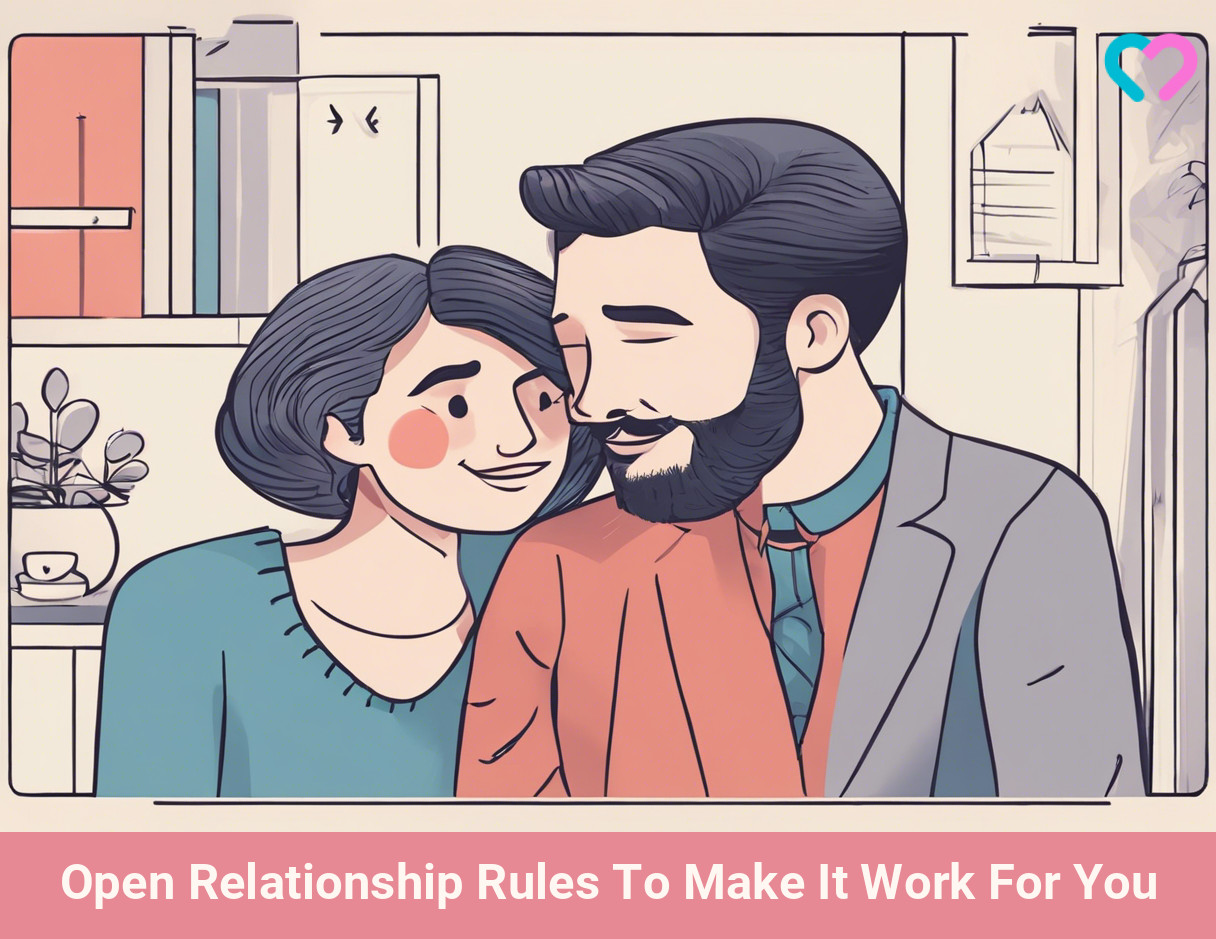
Image: Shutterstock
An open relationship is a type of relationship where both partners agree to have a love or physical relationship with other people. Open relationship rules are certain mutually agreed-upon guidelines essential for the relationship. These rules help the partners manage their relationship better while remaining in a consensually non-monogamous relationship. Here we have listed several rules and answered your questions regarding open relationships and their practicality.
Can Open Relationships Work?
An open relationship is being successfully practiced by couples across the world, irrespective of demographic peculiarities.An open relationship is being successfully practiced by couples across the world, irrespective of demographic peculiarities. A common point of concern is that couples who are on the verge of separation open up their relationship as a last-ditch effort to save it. Dani, a mother in a polyamorous, open relationship with her husband, candidly talks about this issue. She writes, “ I am sure, that at times, people do reach for an open marriage when they are trying to avoid divorce or deal with issues in the bedroom. We (she and her husband) were absolutely certain this wasn’t us, but when we recently looked at getting divorced, we had to re-examine our motivations for being in an open marriage and see if they were because of sexual or other incompatibilities.
“For a while, we wondered if our issues had unconsciously led us to choosing an open marriage. But, actually I think it was the other way around. Despite our issues, we still managed to both grow in the same direction and realize that our desire for polyamory is authentic to who we are. It isn’t a last stitch effort to stay together sort of thing (i).”
The key to an open relationship is honesty, communication, mutuality, and transparency. However, both partners have to be enthusiastic about the relationship. If one is interested and the other is not, then the open relationship will not work. A person should have a broad mind and unwavering trust in their partner. Hence, if you and your partner understand and respect each other, an open relationship can be seamless.
How To Deal With An Open Relationship?
Image: Shutterstock
Managing an open relationship can be tricky and hence you need to have preset boundaries to make it work. Have an honest conversation with your partner about your expectations and the rules to keep your relationship intact. So whatever a couple agrees to do, they should stand firm by that.
Once in an open relationship, there is no going back anytime soon, and you should be prepared to handle all situations. Otherwise, you will lose your partner’s trust, which will lead to rifts in your relationship. It’s important to consider everything before getting into an open relationship.
Seven Open Relationship Rules
Just like any other relationship, proper communication, equality, and understanding of boundaries are the founding stones of an open relationship.
1. Physical intimacy boundaries
Before getting into an open relationship, the couple should thoroughly deliberate on how many partners they can sleep with at a time, what types of physically intimate acts are acceptable, and how often they can get physically intimate. Both the partners should clarify these things before opting for an open relationship.
2. Emotional boundaries
Image: Shutterstock
One of the major issues a couple confronts in an open relationship is jealousy. Although both may think they won’t get jealous of their partner’s affair with others, things may worsen later. It is also important to discuss whether they can get physically intimate without developing feelings for their partner or if it will affect their primary relationship. Talk about ways to get out of an open relationship if one of you wants to.
3. Have open communication
Communication is an integral part of any relationship. Partners should make sure there is no communication gap, and they are on the same page. An open relationship brings significant changes in the lifestyle and relationship of the couple, and through regular interminable communication they can stabilize their relationship. Similarly, being transparent and open also makes things easy for the couple.
4. Determine how to talk about relationships with each other
Talking about the progress of the affair with the new person or persons is crucial for your primary relationship. So deciding what to talk about and what not to talk about in various relationships you get into is essential for keeping the primary relationship stable.
5. Practice safe physical intimacy
When both partners indulge in physically intimate acts with multiple people, there is a chance of contracting STDs. Unprotected intimate acts also increase the risk of unwanted pregnancies. Hence, the couple should ensure they take safety precautions before getting physically close.
6. Be honest
Honesty can go a long way in a relationship. Nevertheless, it becomes even more important in an open relationship. An open relationship is built on trust, transparency, flexibility, and honesty, and when the partners start hiding things from each other and lying about their affairs, things may get complicated. However, they can decide what to share to curb miscommunication.
7. Invest in your primary relationship
Image: Shutterstock
Whatever happens, your primary relationship should be your priority, and both partners should put in individual and deliberate efforts to improve your relationship. Hence, make an agreement upon the time you both should spend together and draw guidelines to keep the spark alive. Also, make sure you put your partner first when planning anything exciting- be it a dinner date or other fun activities.
Benefits Of Open Relationships
Are the emotional and physical risks of an open relationship worth it? Some couples may find it worthy. Opening yourself to new experiences may increase the intimacy between you and your partner. You might get a better idea of your partner, their likes, dislikes, fantasies, and vulnerabilities. You might be more aware of the emotional and physical needs of each other over time.
Image: Shutterstock
Moreover, you can explore each other more. When you both indulge in physical relations with others, you will be introduced to new intimate activities and will be able to identify your fantasies. Subsequently, you both can bring new varieties into the bed and spice up your life.
Similarly, open relationships bring down resentments as both partners have options to make up for what is missing and meet their expectations. Hence, you are not likely to feel resentment easily.
Drawbacks Of Open Relationships
Image: IStock
When multiple partners are involved, an open relationship can trigger jealousy in the partners. There is also the looming risk of contracting STDs and accidental pregnancy. Moreover, being in an open relationship is still largely unacceptable in society, and you may have a hard time justifying your choices.
An open relationship may not get the kind of acceptance that a monogamous relationship gets. A study from The Wheatley Institution and School of Family Life at Brigham Young University revealed that 90% of the Greatest Generation agreed that committed couples should practice monogamy. Similarly, 85% of Boomers and 63% of Millennials preferred a monogamous relationship. When asked if they would consider an open relationship, 15% of Gen X and 13% of Millennials said they would.
Changing opinions on open relationships across generations
Source: National Survey Reveals Generational Differences in Consensual Non-monogamy; Institute for Family Studies/Wheatley Institution/YouGov/iFidelity surveyFrequently Asked Questions
1. Can an open relationship be one-sided?
Open relationships can be one-sided and may work depending on the couple. Sometimes, one-sided relationships may occur when one partner is not interested in physical intimacy and they mutually agree on open relationships. In other scenarios, it can be successful in imbalanced interpersonal relationships where one partner controls the other, and the other invests more time and energy in the relationship. This imbalance can be due to one partner’s interest in open relationships. It is completely a personal choice of partners based on their interests.
2. What is an open relationship called?
Consensual non-monogamy can be another name for an open relationship since both partners agree on a relationship that is non-monogamous. It can also be called polyamorous relationship or polyamory. On the other hand, polygamy means having more than one spouse.
3. What are some common misconceptions about open relationships?
The most common misconception is that couples in an open relationship lack commitment. Couples can engage in physical relations outside their marriage and still be committed to one partner. Another misconception is that partners do not feel jealous in an open relationship, which is not the case. Jealousy does crop up in an open relationship and needs to be well-managed by both partners to continue having a healthy relationship.
4. What causes open relationships to fail?
Open relationships may fail for reasons such as a lack of effective communication and boundary-setting, which can lead to misunderstandings and conflicts. Furthermore, when jealousy and insecurity are not managed well, it can cause trust issues and create resentment, which can strain the relationship.
5. What is the difference between polyamory and an open relationship?
In polyamory, the partners are in more than one romantic relationship at the same time, with the knowledge and consent of everyone involved. It also seeks to build meaningful connections with multiple people, romantically and platonically. In open relationships, a couple is free to have romantic or sexual relationships outside of their partnership. Unlike polyamory, the focus is on the primary relationship while seeking new experiences with others. Transparency and setting clear boundaries are essential in polyamory and open relationships. The partners must be honest, respect each other’s feelings, follow the rules, and ensure everyone is on the same page.
An open relationship can be tricky if there are no boundaries or a mutually agreed set of guidelines. Rules bring in balance to all your relationships and make the experience worthwhile while keeping the foundations of your primary relationship intact.
Infographic: Things You Should Know About An Open Relationship
Being in an open relationship requires consent and mutual understanding from both partners; otherwise, it can lead to complications. So, if you’re considering having an open relationship, check out the following infographic on the guidelines and difficulties one may face in such a relationship to make an informed decision.
Illustration: Momjunction Design Team
Key Pointers
- Open relationship rules help set a common ground for partners who want to explore intimate relationships with others.
- Defining boundaries of physical intimacy and emotional involvement with others is one of the aspects of open relationship rules.
- The lack of rules may make it difficult to manage the primary relationship.
Image: Stable Diffusion/MomJunction Design Team
Open relationships are not easy to maintain. They can be complicated to understand and follow. Watch this video to learn some valuable lessons and gain a new perspective on open relationships.
Personal Experience: Source
MomJunction articles include first-hand experiences to provide you with better insights through real-life narratives. Here are the sources of personal accounts referenced in this article.
i. FAQs.https://andotherthingsthatkeepmeupatnight.wordpress.com/tag/open-marriage-rules/
References
- Forrest Hangen et al.; (2019); Delineating the Boundaries Between Nonmonogamy and Infidelity: Bringing Consent Back Into Definitions of Consensual Nonmonogamy With Latent Profile Analysis
https://pubmed.ncbi.nlm.nih.gov/31584295/























